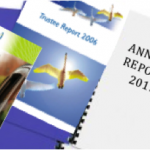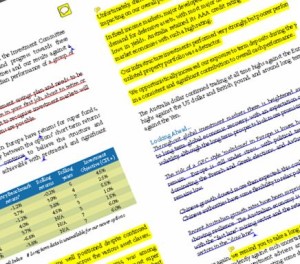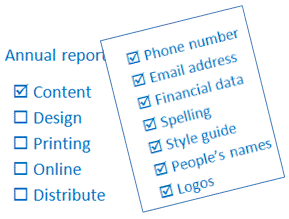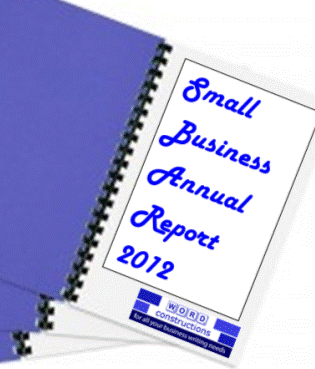I hope you find my writing and business tips and observations useful. My business and blog are dedicated to helping businesses communicate clearly and reach their potential.
Read, subscribe to my newsletter, enjoy!Tash
Why add to an annual report…
There may be a number of inclusions in a package with an annual report. And there are good reasons for them to be, too.
Reasons to add materials to an annual report
On one hand, you may wonder why not just put all the information into the annual report itself and just send that. It’s a fair question, and certainly should be asked about each individual item you are considering adding to the package, but it doesn’t exclude everything.

Saving money, ability to add forms and marketing are just some reasons to have annual report inclusions.
Some reasons to add other items include:
- some things are too hard to incorporate into the annual report, such as long forms you need completed and returned
- some items are worthy of keeping visible which is a bit hard to do if it is in the middle of an annual report – things like an event calendar or a reference list or flow chart
- a loose flyer may be looked at, and then read, whereas an annual report may just be filed away (including in the bin!) without actually viewing any internal pages
- if something needs to be sent at a similar time as the annual report, putting them together saves money (in envelopes, postage and handling) and is generally less annoying for recipients, too
- it is a marketing opportunity as you are already contacting those people so at no extra cost you can make more of an impact (no extra mailing cost that is!)
Of course, it is very important to not overdo it, too. Nobody wants to open an envelope and have sheafs of paper fall out at them!
Any more than three or four inclusions would set off alarm bells for me and I could carefully reassess the value of each inclusion before sending so many items. Too many items in the package distracts, too, so the impact of each would be diminished.
How many inclusions would you find too many as the recipient of an annual report? Have you ever received a ridiculous number of items in a package from a business?
Annual report inclusions…
Any time you receive an annual report, is it alone in the envelope (or email these days) or is there something else with it?
More often than not, I bet there is something else with it, even if it is just a covering letter.
Certainly when I prepare and manage annual reports I also prepare additional items to be sent out at the same time.
what goes along with an annual report?
Pretty much anything could be added to an annual report, but the most common examples of annual report inclusions are:
- a covering letter
- a flyer about special offer or promotion (even if promoted in the annual report, a flyer can stand out and may stay on a desk longer)
- a flyer to launch new service/product
- a form to collect information on something promoted in the annual report
- a form to support a usual product to order (that is, if many people buy your product at this time of year or when reminded, give them a reminder! Also very useful for services that are often done annually.)
- a form to register interest in an upcoming event or change
- annual statement for members
- information about an upcoming major change or event, especially if there are regulations about how that information is to be presented or it needs to be personalised to each person
- some sort of marketing item, such as a calendar, notepad or magnet, that will stay visible even when the annual report is filed away
- perhaps a marketing based magazine although that seems pretty pointless to me as all that could be incorporated into the annual report unless you have a periodic magazine due out then anyway.
Annual report tasks can be outsourced for many benefits
While there are a few tasks you can outsource when preparing an annual report, one I love is checking edits.
That is, when the designer returns a draft to me, someone else goes through and checks the designer has implemented all the changes I requested.
Why check everything? Well, I trust the designers I use, no question about that. However, they are human so may have missed something or misunderstood what I wanted. Or they could have made a simple error (eg made $654 into $664 instead of $646).
Benefits of outsourcing edit checks
Having someone else check those details has two major advantages in my eyes:
- I don’t have to do it! Ok that is really a third reason as my original point was that it saves me time to not have to do it, but it’s not something I enjoy either
- by not reviewing those small details as often, I am better positioned to actually read the report and thus spot issues with the flow or tone of information. If you see the same words and images over and over, it gets much harder to see errors – like putting space between writing and proof reading
I guess you don’t need to find a highly skilled person to outsource checking edits, either – as long as they are detailed orientated, it isn’t a hard task. I am lucky to have found someone I trust for many tasks as he not only checks edits have been made but will suggest other potential improvements he notices, too.
Outsourcing frees up time
To me, this is the perfect example of outsourcing and leaving me more time to use my writing skills.
What is the perfect task for you to outsource?
Do you outsource that task?
Checklist for finalising an annual report
Producing an annual report is a huge job – there are so many details to co-ordinate. Before signing off a final draft, I always get the following items checked at least once, often using different people for specific list items so they can focus and are more likely to spot any errors.
Annual report checklist
- company data
- ABN and similar numbers
- phone number
- address
- online addresses
- logo is present and used according to the style guide
- contents page numbers
- spelling (especially company, people and product names)
- technical details (eg is it $36 per 100g or 100kg?)
- figures and data (eg financial tables, returns data)
- people in photos are named correctly
- labels on images are correct and with the appropriate image
- mandatory details are included (various industries have specific items that must be included)
- images and graphics are appropriate for the brand and ok to use (copyright, model permissions, etc)
THEN
- report flows from cover to cover (ie read every word in order)
- check everything fits correctly (eg remove orphans and align page breaks)
If all the above have been checked thoroughly, your annual report is correct and can be signed off ready for publication.
It’s easy to rush through this section because time is running out nad everyone’s a bit over the whole project by the end. However, it is such an important part of the process and needs to be carried out diligently (such as having multiple people involved).
When planning the annual report process, I always allow a week and preferably two weeks for the review. Not only does this reduce the rush, it gives me spare time if changes are required and a second review becomes necessary.
Do you have a checklist for finalising an annual report or similar large project? Do you involve multiple people in the review process?
Are annual reports just for big business?
What do you think of when you hear about an annual report?
If you’re like most people, you think of thick, boring document produced by big business each year, sent out to shareholders who never read them. And there is a certain amount of truth to that, too.
Annual report rules
If you’re new to business, you may suddenly wonder about annual reports – and if there are any rules meaning you have to produce one, too.
The good news for SMBs is that annual reports are not mandatory for every business. However, once you register as a company you may have to produce annual financial reports (which is usually presented as an annual report).
You may also need to produce some sort of annual report if it is stated in your constitution, deed, financial agreement or other controlling document.
Generally speaking, the rules apply to the financial information you must include; the remaining information is an account of the business for the prior 12 months and is often determined by the company itself or the associated industry standards.
Creating an annual report
So if you don’t have to prepare an annual report, can you?
Yes, any business can prepare an annual report – and add whatever you like to it if you are doing it voluntarily!
A good annual report is a mix of general information, financial information and marketing. It is used by people to decide if they want to invest with the business – whether that means a direct investment as a shareholder or as a client – or even be associated with the business (such as an employee adviser or supplier).
Having an annual report certainly adds an air of professionalism and credibility to any business, and you can limit the financial information if you wanted.
On the other hand, it can be time-consuming and expensive to produce an annual report so it’s not something to be taken lightly.
For a business that doesn’t have to produce an annual report, do you think there is much value in doing so? Would you consider creating one for your business?
Choosing an annual report cover image
As important as the content is, the cover of an annual report also needs time and consideration to ensure the report conveys the desired message.
Let’s face it – people see the cover before they read any content so it has the power to set the tone for how people approach reading the report.
A good cover will also attract attention, meet the company brand and complement other company materials.
Choosing an effective cover image and design
Although I let designers be creative with annual report covers, there are factors I consider in preparing a design brief and in choosing the final look.
Some questions I try answering are:
- what did last year’s report look like, and how similar should this year’s be?
- what central messages have been used during the year? For example, if a theme was used in a lot of marketing I will work that into the cover as well to reflect the year being reported on and maintaining consistency
- what are the core elements of the company brand? Can I work them into the cover through design and/or choice of images?
- are the images unique to this company? It’s a terrible feeling to prepare a lovely cover just to see the same image on a competitor website a week later…
- does the cover look fresh and different? A plain white cover with a logo is simple but can be boring and doesn’t stand out
- is the image working with or against the brand? For example, a smiling person can look professional or kitsch so the specific photo is just as important as the concept being used
- is there anything in the image that could offend or mislead? Many people have been caught out by some little detail in the background of an image – never assume no one will notice!
- could we adjust the image to better suit the brand or cover? Looks at things such as swapping which way people are facing or adjusting colours of people’s clothes
- will one image overpower or give the right message? Will multiple images be distracting and busy, or give a broader overview?
- if using a tagline on the cover, does it work with the image and design? Change the less important aspect if they aren’t working together
Using images
Being such a prominent position, it is crucial to ensure you have the appropriate rights to use any image on the cover of an annual report. If someone else provides the image for you, check the rights yourself as mistakes will be costly.
If you don’t own the copyright of the image(s), check carefully that usage rules allow you to put the image on the cover and make any changes you want to – don’t assume that royalty free images can all be used in the same way.
Have you ever chosen the image for an annual report cover? How did you choose which one was the best fit?
Repeat annual report content?
 Most annual reports contain the same general information year after year.
Most annual reports contain the same general information year after year.
Whether it is an introduction, history of the business, outlining products, naming directors or key staff, there are sections of an annual report that don’t change much over the years.
Repeat the wording?
The fastest option therefore is to use exactly the same wording in those sections every year, just changing small details as necessary. The freshest option would be to rewrite all those sections.
There are pros and cons to both options, such as:
- if you assume most people don’t read annual reports from cover to cover, and probably don’t remember last year’s report in depth anyway, not changing the words would probably escape attention from the majority of people
- repeating the wording not only saves you time rewriting the content but also in gathering feedback and approvals on it – it was approved last year so will meet the criteria this year too (if major style changes have occurred, copying old content isn’t an option!)
- it looks a bit slack and old to anybody who does notice the wording hasn’t changed
- it is easy to make errors when you assume ‘oh it was ok last year so I’ll just skim read this bit’ and miss the reference to ‘our new office’ a year later or forget to update 2012-11 to 2011-12.
- content from the annual report can be copied and used elsewhere because it is approved, public information. Updating the content each year is a nice way to update basic information in numerous places so your profile is kept fresh and interesting
- depending on how your annual report is presented online, you could end up with what appears to be duplicate content on your site (if four pdfs are all 33% the same, for example, there will be a lot of repetition). Search engines do not like duplicate content and can penalise your site for it
- staff can get bored rereading the same words – new content gives them fresh wording to utilise in presentations and on phone calls, too
So what do you think – would you be unhappy getting an annual report that was largely the same as last year’s? Would you even notice?
identifying annual report tasks
 I find it interesting how little many people know about the process of writing and preparing annual reports.
I find it interesting how little many people know about the process of writing and preparing annual reports.
Many people just accept an annual report exists, glance it and forget about it. Other people think annual reports are a good idea and that someone can just sit down for a few hours (maybe a couple of days) to write the report.
If only it was that simple!
I have already started on one client’s annual report – it won’t be released until September, so that gives you some idea of how long it can take.
So here is a list of tasks involved in producing a professional report that meets all legal, business and branding requirements professionally:
- checking what legal and regulatory requirements apply and ensuring those requirements are met. I often start with checklist of topics to include so I don’t forget any of them
- deciding on a theme, if suitable, as this will influence the exact wording and design, and possibly some of the actual content
- collating relevant information, such as major events, financial reports, directors’ details and performance data
- arranging the design and layout – this may mean finding a designer or using an in-house person, but will require time and various drafts
- writing the actual content – which may include writing the bulk of individual reports (Chair’s report, CEO Report and so on) and writing marketing material
- collating relevant images to be used in the report – or editing and approving those collected by the designer
- deciding on marketing elements and then preparing them – you can insert ads for various products/services or even accept external ads as long as you have space and it meets all relevant rules
- editing, rearranging and refining to get everything to fit nicely!
- coordinating feedback from a variety of people (for example, technical, financial, legal, marketing and company experts)
- reviewing final drafts to ensure the report meets the requirements from step 1, meets the business style guide, has all spelling and grammar correct, is readable, appears professional and somewhat attractive, has all correct numbers (check phone numbers, ABNs and addresses are perfect as typos are easily missed) and is approved by the responsible people
- arranging printing – even with digital copies available, some printed copies are usually required – and digital access (formatting and uploading the document and adjusting webpages and links to make it accessible)
There also the additional tasks of arranging distribution (so designing and printing envelopes, arranging mailing lists and stuffing envelopes) and any other materials to go with the annual report (such as member statements, renewal forms and marketing flyers) that may be part of ‘writing the annual report’ or managed by someone else.
It is a lot of work and there is certainly some pride in the final result of your hard work, but it can be a little frustrating when you realise that many people just don’t open or read the annual reports they are given!
An annual report by any other name…
I sometimes refer to writing annual reports for clients, but you may know those reports by another name such as:
- trustee report
- annual trustee report
- shareholders’ report
- report for members
- membership report
- AGM reports (although these are often simpler and delivered orally)
- company report
- annual credit report
Are there any other name you use or know for annual reports from a company or similar entity?
Collecting annual report content
Writing an annual report for many people is a big chore done over a stressful month or two just before it is due to be released.
I have suggested before that the process is better spread across the year by keeping notes so that the actual preparation is easier.
Another way I work on an annual report throughout the year is to copy chunks of text into an annual report document as well. This is content worked on during the year for a specific topic or use – for example, descriptions of a new service or product launched during the reporting year.
When it comes to writing about those topics in the annual report, I can pull out the existing, correct content and adjust it to need. It is much quicker than reinventing the wheel with new text or wasting time searching for that text “I know I wrote back then”.
Although a style guide often includes sections of useful text to be reused, it doesn’t always include text about specific events or external factors.
Can you imagine how organised you will feel and look when you pull out a page of pre-prepared text when you start writing your annual report content?






Recent Comments